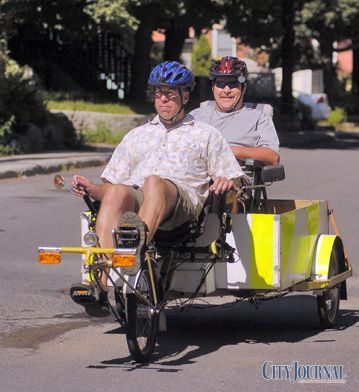
Human Powered Vehicle Club of Ottawa member mark Rehder, who’s moving
house via bicycle, pulls fellow clubman Pete Blackburn in his
custom-built recumbent bike. Photo by Darren Brown
Tapping into a forgotten energy source
Juergen Weichert lets out a slow, deep laugh and pauses for a moment, thinking.
I’d
just told him of an oversized recumbent tricycle, powered via pedals, I
saw streaking down Gladstone the day before last. The thing was doing
about 50 km/h and hauling a washing machine in its ample trailer when
it blew by me.
I’d usually chalk up an apparition like that to a wicked hangover, but not this time.
“You probably saw Mark,” Weichert finally says. “He’s actually been doing the majority of his house move by bike.”
“By
bike?” I exclaim, staggered. As it stands I consider moving, even with
a sturdy cube van, a task roughly akin to dislodging my own eyelashes.
So imagine my surprise.
“Yeah,” he answers, adding it’s his
friend’s second time moving house – that means tables, chairs, desks,
appliances, beds, maybe even the kitchen sink – via human power. The
crew, a collection of engineering and aviation graduates, did their
first all-bicycle move five years ago and haven’t looked back since.
“He was most likely riding a vehicle we built together here in my driveway, in fact,” he continues.
Weichert
and his friends, some of whom are completely car-free, are all crazy
for recumbent bicycles. They’re those low-to-the-ground, slightly
ridiculous-looking but oddly practical pedaled contraptions. They’ve
even started a downtown-based club, the Human Powered Vehicle Operators
of Ottawa (HPVOO), to promote their activity.
The club meets every Sunday evening at Vietnam Noodle House on Somerset, following an hour-long ride through downtown.
“Here’s
the thing,” he says. “We’re sucking tremendous amounts of energy as a
society. And we’re exhausting tremendous amounts of carbon dioxide into
the atmosphere.
“And the forgotten energy source is human power."
Weichert’s
crew says recumbents are anything but ridiculous; indeed, they maintain
the machines could be city-borne road travel’s wave of the future.
“It’s much more comfortable to ride, first of all,” says Weichert. The
sturdy seat back, he explains, provides ample leverage in which to
generate more torque than a typical bike.
“Plus it’s got less
aerodynamic resistance. So consequently, with the given energy input,
you can go faster, longer and further,” he says. “It’s a far more
efficient bike.”
Fast, lightweight and reliable, Weichert says
their recumbents – many of which he’s fashioned from welding old
conventional bikes together – can tow huge loads and even be fitted
with roof racks for carrying a canoe.
“After the first human
powered move, we realized there could be a need for a bigger trailer
than what we had,” recalls Weichert. They sketched out a design for a
1,500-lb. capacity behemoth and welded it up, again, in Weichert’s
driveway.
“It’s what we call the organ trailer, because we can fit an entire Hammond organ, the organist and the power source,” he says.


 Weather: Ottawa, August 6th 2007 / 24°C
/ Partly cloudy
/ Wind: 6 Km/h / Humidity: 65 %
Weather: Ottawa, August 6th 2007 / 24°C
/ Partly cloudy
/ Wind: 6 Km/h / Humidity: 65 %  by Jim Donnelly
by Jim Donnelly 